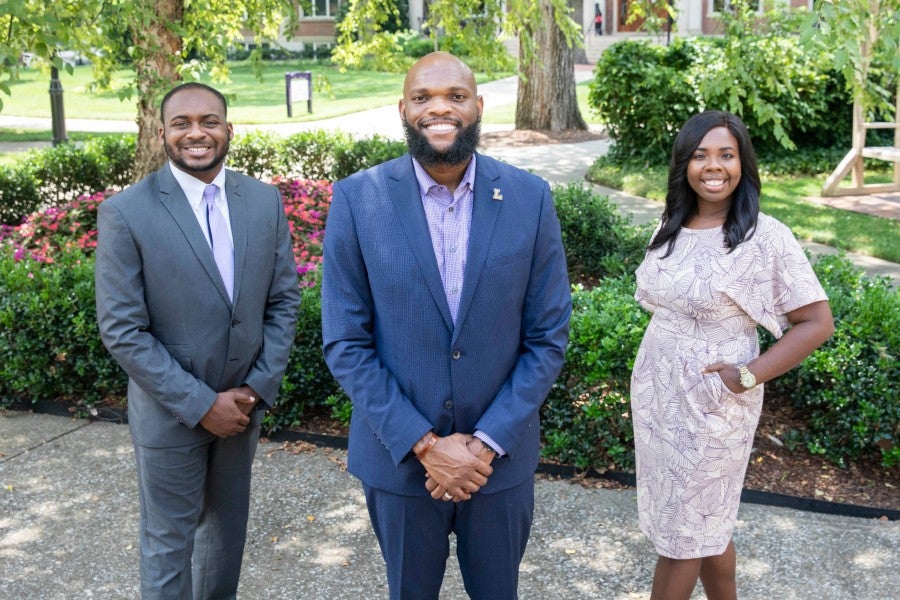Student Life re-structures student leadership to promote inclusion for all
The Office of Community Life celebrates a year of bringing more collaboration and engagement to the student body leadership.
Janel Shoun-Smith | 615.966.7078 |

Kelvin Kelley (left), director of community life, student productions and social clubs; Prentice Ashford (center), dean of community life; and Candace Williams, director of community life, OID and student organizations.
Singarama, social clubs, student government: they are all sources of happy memories for generations of Lipscomb students.
Now the Office of Student Life is working to make those memories even richer by encouraging greater diversity among students involved in such programs by boosting collaboration and engagement among the leaders of various student activities.
In the summer of 2019, The Office of Student Life merged several areas into one, bringing the Office of Intercultural Development (OID), student productions, social clubs, the Student Activities Board and the Student Government Association under one administrative umbrella: The Office of Community Life.
According to Prentice Ashford, dean of community life, the move was intended to smooth out administrative inefficiencies and encourage students to interact beyond their demographic silos.
The previous structure, with three supervisors over the areas, often resulted in multiple versions of one type of event (i.e. an on-campus movie night) that were often attended only by students involved in the particular hosting group. It also did little to break down students’ tendencies to socialize within their own demographic group, he said.
“These areas made up the whole of the Lipscomb student experience and prior to the 2019-2020 school year, communication and interaction between the areas was not prevalent,” Ashford said.

One specific goal is to develop more ethnic diversity among student performers in student-led musical productions, such as Singarama.
Now through the merged Office of Community Life, Ashford and his two directors, Kelvin Kelley, who is over student productions, the Student Activities Board and social clubs, and Candace Williams, who is over the Office of Intercultural Development and Student Organizations, guide the 30 student leaders of all these organizations.
“Lipscomb has roughly 30 student leaders who are responsible for all student engagement on campus. So if you are elected or hired, it is really a significant role, and it is therefore important that those 30 leaders are all in sync about what offerings are brought to students and what policies affect students,” said Ashford.
The student leaders now meet together a few times a year, making it easier to collaborate between groups, eliminating some of the red tape in producing events and encouraging members of various groups to become involved in new types of activities. At the end of each semester, all the leaders attend an intentionally designed leadership training.
This year, student leaders are working to develop a new fall production and another show solely for freshman to perform during Homecoming and Family Weekend. Student Organizations is working on ways to grow the number of organizations on campus, and OID has expanded its internship program for students.
In addition, OID and Lipscomb’s Light Program, an academic program that provides students an understanding of cultural practices, systems and institutional structures, partnered to supply every freshman in the Lipscomb Experience class this fall with a copy of the book Just Mercy, by Bryan Stevenson, founder of the Equal Justice Initiative.
“Everybody coming together streamlined communication and made everybody think about what the student body as a whole wants to do collectively,” said Ashford.
One specific goal is to develop more ethnic diversity among student performers in student-led musical productions, such as Singarama. Another goal is to bring more ethnic diversity to the social club membership. And an overall goal is to boost students’ awareness that there is room for many voices in the decision-making process for the student body, said Ashford.
“If we can get students to socialize first, then working together becomes much easier,” Ashford said.
The 2020-21 school year has brought new on-campus challenges with COVID-19, but Ashford doesn’t expect those challenges to harm the department’s goals to provide a sense of community on campus. This year. students are pre-registering for events, which will provide more accurate data for the future, and multiple events are being held to allow as many students as possible to participate, despite attendance limitations.
Other milestones:
In recent years, the Office of Student Life has established and refined other programs designed to introduce new students to the conversation about what it means to be a culturally aware and accepting individual attending a university:
- Three years ago Lipscomb established a diversity training and dialogue session within Quest Week, the university’s orientation week for freshmen and transfers. OID carries out the training designed to set the expectation that the Lipscomb community is one that is respectful to all. The sessions recognize the unique makeup of the incoming class and how its differences in experience brought to the campus are what make Lipscomb a stronger and better place.
- In addition, four years ago OID established life culture competency training for the 52 students on the residence hall staff. This training includes cultural awareness, how to identify microaggressions and other important areas.